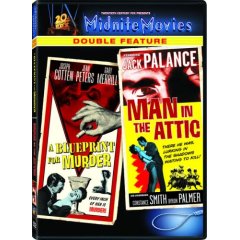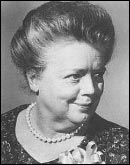As our film opens, I see the production logo for Panoramic Productions. At first I thought, “How strange.” I don’t remember seeing this before (although I may have), and now I’ve seen it twice in a week, the first time being before Gorilla at Large. Then my brain belatedly kicked in, and I realized both Gorilla and Man in the Attic had been released in the same batch of Midnite Movie DVDs. So obviously they were drawing from a pool of films that included the Panoramic slate. Mystery solved.
As opposed to Gorilla, set in modern day
However, the movie turns out to be based on the oft-adapted Marie Belloc Lowndes novel The Lodger, which is based on Jack the Ripper. The book previously came to the screen under the title The Lodger in 1927 (by Alfred Hitchcock), 1932 (with the same leading man as starred in Hitchcock’s version), and most famously in 1944, with Laird Cregar as the killer. Cregar died soon afterward, and a promisingly acting career was cut short. That version, coincidentally enough, is soon to be released as one of the three films featured in the “Fox Horror Classics Collection,” along with the suspense pictures Hanover Square and the early werewolf flick The Undying Monster.
The screenplay for this version, however, was co-written by Barre Lyndon, who worked on a lot of gothic horror and some sci-fi projects. He wrote the play The Man in Half Moon Street, about a scientist who had extended his youth for a hundred years but had to kill periodically to do so (filmed twice, in 1945 and by Hammer as The Man Who Could Cheat Death in 1959). He wrote the screenplays for the aforementioned Hanover Square , George Pal’s The War of the Worlds (1953), Conquest of Space (1955), and the Leslie Nielsen horror flick Dark Intruder (1965). From this, it’s obvious that suspense plot set in Victorian England were his specialty. He also wrote for some gothic TV shows like the Boris Karloff hosted Thriller, and The Alfred Hitchcock Hour.
We open with a nice foggy murder, the latest crime by Jack the Ripper. The police, converging en masse following the victim’s screams, inevitably arrive too late. In real life, the Ripper had a lot more time with his victims, as he more or less dissected them. However, there’s no way that would fly back in 1953.
(By the way, given the thick Cockney accents of many of the cast, some subtitles would have been appreciated. Seriously, how much can that cost?)
Then we move to the house of Helen and William Harley, a chattering, picaresque couple presumably meant to evoke the comically middleclass fuddy duddies of Dickens. I might not have recognized the names of the actors playing them, but I did know their faces. William is played by Rhys Williams, a balding, plump character actor who appeared in a zillion movies and more TV shows. Meanwhile, Helen is played by Francis Bavier. Ring any bells?
How about now:
That’s right, it’s Aunt Bee. You can imagine how distracting that is.
Anyway, the couple’s good natured, folksy chatter is interrupted by a knock at the door. It’s a tall, cadaverous but soft-spoken man who introduces himself as Mr. Slade. He’s come in answer to the Harleys’ advertisement of rooms to let. Our suspicions immediately focus on Slade, because he is played by Jack Palance.*
[*Palance, naturally, is a lot younger here than we are used to seeing him, and in fact looks quite a lot like a taller Henry Silva.]As the city’s panic grows, the Harleys slowly begin to suspect their lodger of being the killer, not least because of his long
Inverness coat (the sort with the half-cape, like Sherlock Holmes wore) and the medical bag he habitually carries.
Plus, you know, he’s played by Jack Palance.
In addition to a bedroom, Slade rents the attic for vaguely alluded-to experiments. He mentions that he will be keeping strange hours, coming to and fro in the middle of the night. Finally, every even slightly eccentric thing he does—like turning Helen’s ‘quaint’ paintings of actresses in his bedroom to the wall—is accompanied by a Loud Ominous Music Sting. Of course, the middle class in England of that period probably had a pretty narrow idea of ‘normal’ was, so perhaps these aural cues reflect only the Harleys’ perceptions and not plodding directorial overkill.
Probably not, though.
Even more ominous is the fact that the Harley’s beauteous young niece Lily is also an actress, a profession that at the time was viewed as the next thing to being a prostitute. (And not, it should be noted, entirely sans reason.) Lily, Slade is surprised to learn, will herself be living in the house as soon as she returns from recruiting “saucy” dancers from Paris. (!!) You just know that’s going to be trouble.
Per usual, the film pauses to present at full length not one but two of Lily’s production numbers, which seem both a bit risqué and rather too elaborate for the music halls of period, even the ones drawing the Prince of Wales. Even funnier is a scene where the film’s two comic relief bobbies escort a comely young street singer from the Auld Sod, who naturally belts out an Irish ditty as they stroll along.
Meanwhile, a former actress-turned-doxie visits Lily before heading off to her inevitable off-camera demise. It’s a point in the film’s favor, by the way, that here the Ripper’s victims are least seem genuinely downtrodden and past their primes (in most cases, anyway), unlike the rosy-cheeked beauties the Ripper’s victims where often portrayed to be in other pictures. Victorian England would not have been an era much kind to middle-aged slum prostitutes.
The beauteous and forthright Lily draws the attention of the usual dapper and stalwart Scotland Yard inspector (although modern audiences will likely consider him an insufferable prig). She, herself, however is drawn to the halting, enigmatic but oddly sympathetic Slade. In contrast, Helen, a snooping busybody in the Gladys Kravitz mold, grows increasingly suspicious of their border. Soon she’s even naming him as the Ripper to others, sans much evidence. In return, her fears are written off as stuff and nonsense by her annoyed husband, and rather convincingly so.
Needless to say, the general source of suspense here (aside from Lily’s inevitable, eventual peril) revolves around whether Slade is, in fact, the Ripper, or merely an innocent eccentric. The signs pointing at him are so pronounced that they seem to a modern viewer certain to be red herrings, although suspense films of this period were not always known for their subtlety. Needless to say, I’ll leave the matter unanswered, for those who may be interested in learning the truth for themselves.
The Man in the Attic is not a top-notch suspense film by any means (let me recommended Hitchcock’s brilliant A Shadow of the Doubt while we’re on the subject). It remains, however, for those tolerant of the slower pacing of older films, an enjoyable potboiler seasoned both by its well-known cast and, obviously, its subject matter. I’m sure there are those who seek out any and all Jack the Ripper movies, and while I’m not sure this one adds anything unique to the mix, it’s a harmless way to pass an hour and twenty minutes.
Probably the most interesting aspect of the film is Palance’s performance, which is actually a nicely nuanced piece of acting. Palance was only in his third year of screen acting, yet was already a veteran heavy, having appeared in such films as Panic in the Streets (1950) and Sudden Terror, the latter opposite Joan Crawford. 1953, actually, saw him in several films, including the role that probably made his career (and established his screen image), that being the menacing gunfighter in the classic Alan Ladd western Shane.
In marked contrast to his better known and generally far hammier acting technique, Palance plays Slade in a reserved, awkward and quiet fashion. Slade never seems comfortable under the scrutiny of another, and here Palance’s famous whisper of a voice seems designed not to draw the listener in, as is usually the case, as to deflect attention altogether.
Meanwhile, his withdrawn nature and pronounced shyness around women call to mind nothing so much as Anthony Perkins’ Norman Bates in Psycho (1960), a full seven years before that film was made. However, Palance’s harshly planed face and tall, rangy build naturally make him more immediately threatening than the deceptively fragile-looking Bates. Indeed, we eventually learn Slade has a big bundle of Mother Issues, much like Norman himself.
The Man in the Attic looks decent in its new DVD release, although the source materials are a bit too grainy to describe the transfer as pristine. It was released recently as part of Fox’s joining of MGM’s Midnite Movie double feature line. The Fox entries in the series, including this one, offer each movie on a separate disc. (The MGM offerings, in contrast, put both films on a single, ‘flipper’ DVD.) Here the co-feature is the well-regarded if minor suspenser Blueprint for Murder. I’m sure Netflix in particular is a fan of Fox’s approach, since if you want to see both movies, you have to use up two rental slots.


